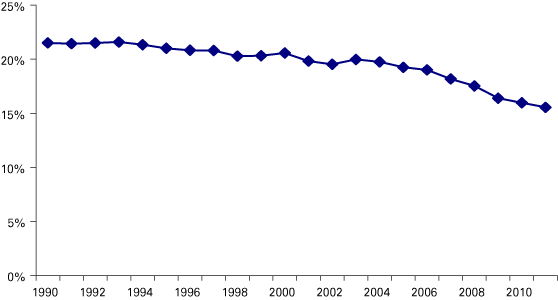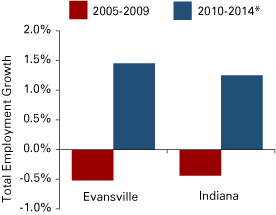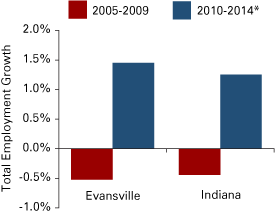Evansville Forecast 2012
Professor of Economics and Dean of Business, College of Business, University of Southern Indiana
Unease about the economy’s performance in 2011 and heightened concerns about the likelihood of a double-dip recession have raised fundamental questions about the role and impact of macroeconomic policies, our understanding of the driving forces behind the changing structure and dynamics of the U.S. economy, and the adjustment processes underlying consumer spending and business investment. At the same time, there is increased focus on investigating the relative influence of technological unemployment and wealth disparity on the trajectory of the economy over the past two decades.
For much of 2011, the evidence shows that there continues to be considerable variation across metro areas with regard to the timing, strength and persistence of the recovery. While previous postwar recessions ranged in length from six months to 16 months for the national economy (averaging about 10.5 months), the 2007–09 recession was the longest recession in the postwar period, at 18 months. In addition, the 2007–09 recession was the deepest recession in the postwar period; at their lowest points, national employment fell 6.3 percent and output fell 5.1 percent. In comparison, employment fell by just over 5 percent and output fell by 5 percent in the Evansville metro area.
In the aftermath of the 2007–2009 recession, the recovery of the Evansville metro economy has become progressively stronger. Following decreases in output and employment in 2008 and 2009, increases in real output, personal income and real retail sales that started in 2010 continued in 2011. The dynamics of the Evansville area labor market reflected these developments. The unemployment rate fell from 9.7 percent in January 2010, to 7.1 percent in September 2011, compared with a drop in the national unemployment rate from 9.5 percent to 9.1 percent over the same time period. In previous business cycles, aggregate hours and employment have frequently reached their troughs later than when the recession has officially ended. The decrease in the unemployment rate in the Evansville metro area during 2011 suggests that household employment has started to rebound at a faster rate than the national economy.
An examination of the output and employment performance of the national economy since June 2009 indicates that the current recovery has been relatively slow compared to the other post-World War II recoveries and the slowest in terms of employment growth compared to previous postwar recessions. The Evansville metro area has coped with the recession better than many metro areas in terms of relatively lower output loss and a relatively lower unemployment rate during 2010 and 2011. Currently, employment in the Evansville metro economy is 98.8 percent of the level of employment at the onset of the recession.
Economic performance in 2011 has been driven by job gains in the health care and education sectors. Employment increases were also evident in construction as well as in the professional and business services sector. In 2011, nominal personal income is estimated to increase by 4.2 percent and real gross metro product is estimated to increase by 2.3 percent. The manufacturing sector continues to be an important base to metro area household incomes and consumer spending activity even as the economy adjusts to an ongoing diversification away from manufacturing-industry dependence (see Figure 1).
Figure 1: Evansville MSA Manufacturing Employment as Percent of Total Non-Farm Employment, 1990 to September 2011

Source: STATS Indiana, using Bureau of Labor Statistics data
The Evansville economy tracked the performance of the United States economy in 2011, with mixed signs of a sustained recovery. Homeowners experienced some home price depreciation as existing-home prices decreased from an average of $91,800 in 2010 to $90,700 in the first quarter of 2011, and mortgage originations are estimated to decrease from $1,220 million in 2010 to $1,012 million in 2011. Between 2010 and 2011, single-family housing permits are estimated to have decreased by 16.2 percent and personal bankruptcies per 1,000 people are estimated to have increased from 5.9 to 7.9.
Given the proportion of output that is sold outside the metro area, the strength of the recovery in the Evansville area is linked to the strength of the broader economy. As the demand for locally produced goods reverts to its pre-recession level, personal income and output growth are expected to maintain their upward trajectory.
For the Evansville metro area, output is forecasted to increase by 3 percent in 2012, the number of jobs is projected to increase by 2,300 and the forecast for nominal personal income growth is 4.7 percent. Figures 2 and 3 provide a comparison of forecasts for the Indiana segment of the Evansville economy and the state of Indiana for the 2010–2014 period.
Figure 2: Average Growth of Personal Income

*Includes forecasted data
Source: Center for Econometric Model Research
Figure 3: Average Growth of Total Employment

*Includes forecasted data
Source: Center for Econometric Model Research
As one of the most manufacturing-dependent metro areas in the nation, the Evansville economy was noticeably impacted since the inception of the current recession. Since 2007, Evansville’s manufacturing workforce has fallen by 15.4 percent or about 5,000 workers, compared to the 16.9 percent reduction in Indiana’s manufacturing workforce over the same period. In 2011, manufacturing earnings continued to be a significant driver of economic activity, accounting for 24 percent of total earnings in the Evansville metro economy.
Even though the pace of structural change in the Evansville economy slowed during the past year, ongoing challenges will arise as a result of long-term adjustments occurring within the manufacturing sector, particularly in the share of nondurable manufacturing (see Table 1). In addition, an elderly age cohort as a proportion of the population that is higher than the state average, and a youth cohort as a proportion of the population that is lower than the national average place greater pressures on in-migration as a source for meeting the region’s human capital needs.
Given the proportion of output that is sold outside the metro area, the strength of the recovery in the Evansville area is linked to the strength of the broader economy.
Table 1: Manufacturing Percent of Total Employment, September 2011
| Industry | Evansville Metro | U.S. |
|---|---|---|
| Manufacturing | 15.6% | 8.9% |
| Durable Goods | 52.6% | 62.0% |
| Nondurable Goods | 47.4% | 38.0% |
Note: September data are preliminary and not seasonally adjusted.
Source: STATS Indiana, using Bureau of Labor Statistics data
Also in this Issue…
- Outlook for 2012
- International Outlook for 2012
- U.S. Outlook for 2012
- Financial Outlook for 2012
- Housing Market Outlook for 2012
- Indiana's Outlook for 2012
- Indiana's Agricultural Outlook for 2012
- Anderson Forecast 2012
- Bloomington Forecast 2012
- Columbus Forecast 2012
- Evansville Forecast 2012
- Fort Wayne Forecast 2012
- Gary Forecast 2012
- Indianapolis-Carmel Forecast 2012
- Kokomo Forecast 2012
- Lafayette Forecast 2012
- Louisville Forecast 2012
- Muncie Forecast 2012
- Richmond Forecast 2012
- South Bend and Elkhart Area Forecast 2012
- Terre Haute Forecast 2012




